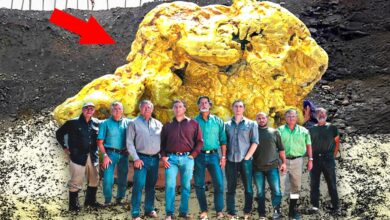This HORRIBLE thing Has Been Found At Oak Island And SHOCKED Everyone!
This HORRIBLE thing Has Been Found At Oak Island And SHOCKED Everyone!

Are we closer to finding an actual physical treasure?
We’ve got a shaft here and maybe it’s the Money Pit. I think the clues are adding up that ultimately we’ll get either ourselves there or someone there.
Oak Island, located off the coast of Nova Scotia, Canada, has been the center of treasure hunting mystery for over two centuries. Generations of adventurers have been drawn to the island, seduced by tales of hidden riches and mysterious secrets buried deep beneath its surface. Despite numerous attempts to uncover its mysteries, many have faced frustration and failure.
However, recent discoveries have reignited passion and hope among treasure hunters and researchers alike, suggesting that the island may finally be ready to reveal its secrets. For over 200 years, Oak Island has captured the imagination and obsession of treasure hunters worldwide. The story began in the late 1700s when a young man from Nova Scotia noticed a mysterious light over the island. His curiosity led him to dig, where he found a man-made pit now famously known as the Money Pit. This discovery sparked the legend of Oak Island, which has continued to lure treasure hunters with the promise of hidden riches buried beneath its surface.
There is every reason to believe that down in those holes, there is something close by that contains a very large amount of silver. The draw of Oak Island lies in its mysterious history and the possibility of uncovering a treasure worth millions. Over the centuries, countless expeditions have been undertaken to uncover its secrets. These efforts have employed increasingly advanced technologies and methods, from basic digging tools in the 18th century to modern excavation equipment and scientific analysis today. Despite these efforts, Oak Island remains a stubborn mystery. The island has yielded only exciting clues and artifacts that deepen the mystery instead of providing clear answers.
Among the fascinating discoveries are ancient wooden structures found deep underground, particularly in the area known as C1. The recovery of these timbers may be a pivotal moment. If they represent original work, these structures dating back to the late 15th century suggest early human activity on the island and challenge previous assumptions about its history. In addition, traces of silver and gold and a stone-paved pathway over 1,200 years old hint at a sophisticated settlement or community that predates previous beliefs about human activity on the island. Could it be an indirect indicator of treasure? Yes, because why go to all this expense and construct this road that seems to have been constructed to be hidden?
Smaller artifacts like a medieval iron spike and a semi-precious garnet gemstone further complicate the mystery, raising questions about their origins and connections to the Knights Templar, a medieval military order. The combination of these discoveries keeps the legend of Oak Island alive. Each find adds another piece to the puzzle, sparking renewed curiosity and determination among treasure hunters. The island’s secrets remain guarded, and the quest to uncover its hidden treasures continues, drawing adventurers into its spell year after year. Despite setbacks and skepticism, the search for Oak Island’s treasure continues, fueled by the hope that one day the island will finally reveal its long-hidden secrets.
Recently, a terrifying discovery on Oak Island has shocked everyone and reignited interest in its mysteries. This new find promises to reveal the island’s dark past and possibly unlock unprecedented riches. The Oak Island team, led by brothers Rick and Marty Lagina, has been at the forefront of these explorations. They have carefully scoured every inch of the island and dug deep into its history to uncover its secrets. The discovery of ancient wooden structures on Oak Island has revealed significant clues about early human activity and impressive engineering feats. These structures, dating back to the late 15th century, coincide with the era of European exploration in the Americas. The Money Pit was described as having found oak timbers, so we believe that some of this material is oak. It’s the first time that we’ve ever seen it, and if these are oak, it’s very interesting. This timing has led to speculation that early explorers or settlers might have been involved in creating these constructions. The level of engineering required to build such structures raises interesting questions about who these individuals were and their purposes for being on the island.
Adding to the excitement, traces of silver and gold were found in the same area as the wooden structures. This discovery hints at the possibility of a buried treasure or valuable cargo, further fueling the long-standing legend of hidden riches on Oak Island. How much silver would it take to fill these levels? Is it a handful of silver or is it a truckload? It’s a truckload. The presence of these precious metals suggests that those who built the structures might have been involved in significant activities, possibly related to treasure or trade.
The idea is to look at water down drill holes that exist. The water in those wells should reflect the chemistry of the ground that they interact with. How would we identify whether or not there was treasure? Another interesting find was a stone-paved pathway in the island’s swampy region. This pathway is estimated to be over 1,200 years old and looks exactly like an old Roman road. It’s possible it indicates a loading or unloading area from a ship, which points to an even earlier human presence on Oak Island. The existence of such an ancient pathway indicates that there might have been a sophisticated settlement or community on the island long before the era of European exploration. This discovery challenges previous assumptions about the island’s history and suggests a rich, complex past that has yet to be fully understood. Each new discovery adds a piece to the puzzle, suggesting a long history of human activity and possibly hidden treasures.
The Oak Island team, led by Rick and Marty Lagina, continues to explore these clues, hoping to uncover more about the island’s mysterious past. The combination of ancient structures, precious metal traces, and a prehistoric pathway offers exciting hints about the island’s history. As the team digs deeper, they hope to uncover the full story of Oak Island and potentially reveal the secrets that have captivated treasure hunters for generations.
In addition to the significant structural discoveries on Oak Island, the team has found a multitude of smaller artifacts that add to the mystery. One particularly puzzling discovery in the B4C shaft was a small iron spike or drill bit. This artifact appears to date back to the medieval or Renaissance era, raising interesting questions about its purpose and the people who used such tools on the island. That is one big spike. Look at the size of that. It looks like a railroad spike, but it’s too big to be a railroad spike. It’s very heavy as well. The presence of this tool suggests that there might have been advanced activities or construction taking place during that time, which adds another layer of mystery to the island’s history.
Another fascinating find was a semi-precious garnet gemstone. This discovery has sparked speculation about a potential connection to the Knights Templar. Look at this, Rick. We’ve got it. Look at how many facets are on that. That is a Bobby dazzler. The Knights Templar, a medieval military order often linked with legends of hidden treasures and the Ark of the Covenant, are the focus of this speculation. The presence of such a gemstone on Oak Island enhances the island’s mystique and suggests a possible historical significance that goes beyond mere treasure hunting.
These smaller artifacts, though less grand than the ancient structures and pathways, provide critical clues about the range of activities and the various groups that may have visited or settled on Oak Island over the centuries. The gemstone presence suggests that valuable items might have been hidden on the island, possibly by the Templars or other secretive groups. Overall, these smaller artifacts contribute to the ongoing puzzle of Oak Island. Each find, whether a tool or a gemstone, offers new insights and raises more questions about the island’s past.
The Oak Island team continues to piece together these clues, driven by the hope that they will one day unlock the full story behind the island’s enduring mystery. One of the most puzzling discoveries on Oak Island was found in Lot 5: a strange material that looked like cement but did not resemble regular cement or mortar. This unusual man-made substance was also discovered near the underground tunnel in The Money Pit area. Finding this cement-like material in two separate places on Oak Island generated a mix of excitement and nervousness among the team members. This peculiar substance seemed to be an important clue, possibly even the key to unlocking Oak Island’s greatest unsolved mysteries about buried treasures.
The discovery of this cement-like substance in Lot 5 and near The Money Pit suggests that it might have been used in significant construction or sealing activities. The fact that it does not match any known types of cement or mortar adds to the mystery. This raises interesting questions about the origins and purpose of the material, as well as the people who used it. The Money Pit has been a focal point of treasure hunting efforts on Oak Island since the late 1700s when it was first discovered by a young man from Nova Scotia. Over the years, countless expeditions have tried to excavate the pit, only to be thwarted by flooding and other challenges. The discovery of the mysterious cement-like substance near The Money Pit adds a new layer to the mystery, suggesting that there may have been advanced construction techniques involved in its creation. The presence of this material in two separate locations on the island implies a deliberate and widespread use, possibly to hide or protect something valuable. It hints at a sophisticated level of engineering and planning, possibly by a group with significant resources and knowledge. This discovery has fueled speculation that the cement-like substance could be linked to the hidden treasures or valuable cargo that many believe are buried on the island. Overall, the discovery of this mysterious cement-like substance on Oak Island adds another piece to the puzzle. It suggests that the island’s history is even more complex and mysterious than previously thought. As the Oak Island team continues their investigations, this peculiar material may provide crucial clues that help uncover the long-standing mystery of the island’s buried treasures.
Despite numerous challenges and setbacks, the Oak Island team remains



